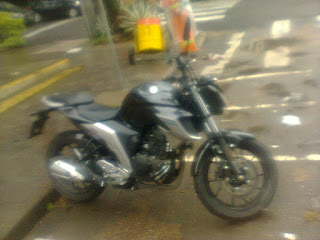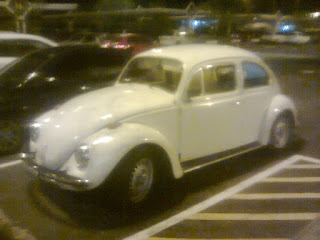Sometimes it might feel kinda temptating to adapt the engine of a motorcycle into a car, due to some inherently simpler design features, plus the expectations for an eventual decrease in fuel consumption and maintenance cost. It may eventually work, but it's not so likely for a 250cc motorcycle engine such as the one fitted to the Yamaha FZ-25 to be a perfect match even for a subcompact car like the previous-generation Chevrolet Spark originally available with 1.0L and 1.2L engines in most markets. Even though the smaller displacement might sound at first as an obvious approach to save fuel, combined to a smaller amount of parts that would require a few replacements throughout the useful life, matching a smaller torque output to some gear ratio that makes it remain useful is quite a challenge, even when the useful RPM range is broader.
Even something not so small, for example a Chevrolet Cruze, might seem as if it would be better served by a Honda CB 600 F Hornet in the eyes of a random shade tree mechanic, instead of the 1.6L Ecotec originally offered in some countries. Despite the lower total power and torque rating for the motorcycle engine, which is no surprise since the Ecotec has a roughly 166% greater displacement, the speed at the drive wheels could be matched in most traffic conditions resorting to a lower final gearing which would still allow a reasonable cruising speed even if the top speed decreases slightly. Considering a 2.5:1 reduction to match only the peak torque speed at the wheels, the stock rating of 63.5Nm at 10500RPM from the fuel-injected Hornet would equate to 158.75Nm at 4200RPM which is slightly better than the 155Nm rating for the Ecotec. However, the fact that most modern motorcycles have their transmission integrated to the engine's crankcase as a single unit makes it harder to bolt them straight to a car transmission, unless both are kept and some cross-shifting might be applied.
The fact that motorcycle engines usually don't have a provision for accessory drive should also be taken in consideration, since it would require either some extensive modification to enable the fitment of an accessory drive pulley or replace all engine-driven systems such as a hydraulic power-assisted steering pump or an air-conditioner compressor with electric ones, eventually overloading the magneto usually fitted to motorcycle engines to provide both electric power and ignition timing. Simply adapting a belt-driven car-type alternator could then become quite troublesome. So, despite being technically possible in some circumstances, the swap of a motorcycle engine into a car may not be always suitable to fulfill the expectations.
Tuesday, July 17, 2018
Sunday, July 15, 2018
What's so great about the Citroën 2CV compared to the Beetle?
Among some "people's car" projects which development started in Europe at the interwar period, the Citroën 2CV is arguably one of the smartest designs. Versatile, simple to mantain and capable to overcome harsh environmental conditions, it served not just the urban folks but also became a valuable workhorse for small farmers. Popular not only in France, but also in Argentina, Uruguay and Chile among other countries, in some of those it reached the same cult status enjoyed by the Volkswagen Beetle in my homeland Brazil.
Debates about which technical solution is effectively better become quite fierce when the front-engine front-wheel drive approach is compared to the Beetle's rear-engine and rear-wheel drive, but the 2CV doesn't disappoint when it comes to off-road capability. Its suspension system with each side wheels interconnected through a longitudinal spring leads it to incline a lot while cornering at higher speeds, but FWD makes its reactions quite predictable, plus it helps balancing the weight bias even while loaded and therefore not compromising its aptitude to go through rough terrain and unimproved roads. The engine, which is often anedoctally quoted as a copy of some early BMW R-Series, is actually quite advanced for its time, featuring overhead valves when BMW still relied mostly on the flathead layout at the time the 2CV was initially designed. Even though the air-cooling and wasted-spark ignition could be deemed outdated, these features were desirable to improve its capability to survive under the extreme cold weather which could damage a water-cooled engine, while the lack of a distributor meant the ignition to be more resistent to water/moisture. With so many clever design features, no wonder the Citroën 2CV served as a base for what might be one of the earliest "crossover" SUVs, the Méhari, which also had the availability of a dual-range 4-wheel drive system as a premium feature despite the regular front-wheel drive serving just right for the overwhelming majority of its buyers.
Front-engine also led to an easier accessibility of the luggage compartment from the outside, and eventually some load hauling. The 4-door body provides an easier access to the luggage compartment from the inside too, and to accomodate bulkier items compared to the Beetle with the rear seat folded. Much like soccer matches, choosing one "people's car" design and singling it out as the smartest or more influent on a worldwide basis becomes quite a passionate matter. But in the end, despite the noticeable difference in the performance which is usually more modest for the 2CV, it's still quite a masterpiece as much as the Beetle.
Debates about which technical solution is effectively better become quite fierce when the front-engine front-wheel drive approach is compared to the Beetle's rear-engine and rear-wheel drive, but the 2CV doesn't disappoint when it comes to off-road capability. Its suspension system with each side wheels interconnected through a longitudinal spring leads it to incline a lot while cornering at higher speeds, but FWD makes its reactions quite predictable, plus it helps balancing the weight bias even while loaded and therefore not compromising its aptitude to go through rough terrain and unimproved roads. The engine, which is often anedoctally quoted as a copy of some early BMW R-Series, is actually quite advanced for its time, featuring overhead valves when BMW still relied mostly on the flathead layout at the time the 2CV was initially designed. Even though the air-cooling and wasted-spark ignition could be deemed outdated, these features were desirable to improve its capability to survive under the extreme cold weather which could damage a water-cooled engine, while the lack of a distributor meant the ignition to be more resistent to water/moisture. With so many clever design features, no wonder the Citroën 2CV served as a base for what might be one of the earliest "crossover" SUVs, the Méhari, which also had the availability of a dual-range 4-wheel drive system as a premium feature despite the regular front-wheel drive serving just right for the overwhelming majority of its buyers.
Front-engine also led to an easier accessibility of the luggage compartment from the outside, and eventually some load hauling. The 4-door body provides an easier access to the luggage compartment from the inside too, and to accomodate bulkier items compared to the Beetle with the rear seat folded. Much like soccer matches, choosing one "people's car" design and singling it out as the smartest or more influent on a worldwide basis becomes quite a passionate matter. But in the end, despite the noticeable difference in the performance which is usually more modest for the 2CV, it's still quite a masterpiece as much as the Beetle.
Subscribe to:
Posts (Atom)










